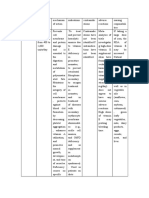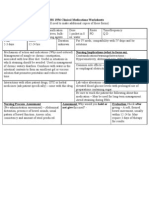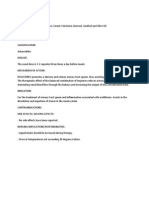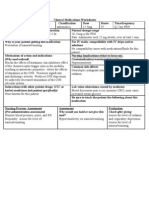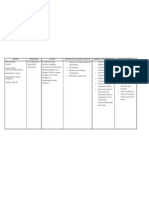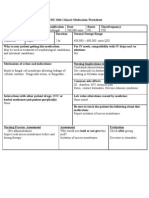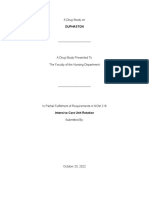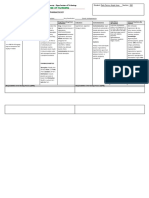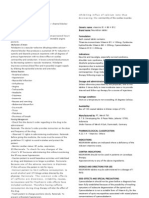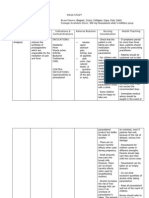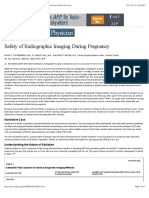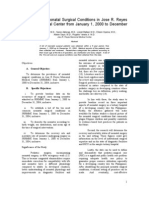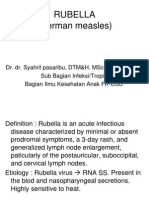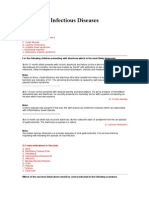Vit. A
Vit. A
Uploaded by
Jule SantoyaCopyright:
Available Formats
Vit. A
Vit. A
Uploaded by
Jule SantoyaCopyright
Available Formats
Share this document
Did you find this document useful?
Is this content inappropriate?
Copyright:
Available Formats
Vit. A
Vit. A
Uploaded by
Jule SantoyaCopyright:
Available Formats
Vitamin A (Retinol) Drug Study Generic Name: Vitamin A Brand Name: Aquasol A General Action Vitamin A is effective for
treatment of conditions such as acne or lung diseases, or for treatment of eye problems, wounds, or dry or wrinkled skin not caused by lack of vitamin A has not been proven. Although vitamin A is being used to prevent certain types of cancer, some experts feel there is not enough information to show that this is effective, particularly in wellnourished individuals. Indication Vitamin A injection is effective for the treatment of vitamin A deficiency. Side Effects Anaphylactic shock and death have been reported using the intravenous route. Allergic reactions have been reported rarely with administration of AQUASOL A Parenteral including one case of an anaphylactoid type reaction. Vitamin A toxicity can cause growth retardation, hair loss and enlarged spleen and liver in its more severe form. Vitamin A overdose can also cause birth defects and has been linked to increased risk of bone fractures in some people. Contraindication: In Pregnancy: Safety of amounts exceeding 6,000 Units of vitamin A daily during pregnancy has not been established at this time. The use of vitamin A in excess of the recommended dietary allowance may cause fetal harm when administered to a pregnant woman. Animal reproduction studies have shown fetal abnormalities associated with over-dosage in several species. Malformations of the central nervous system, the eye, the palate, and the urogenital tract are recorded. Vitamin A in excess of the recommended dietary allowance is contraindicated in women who are or may become pregnant. If vitamin A is used during pregnancy, or if the patient becomes pregnant while taking vitamin A, the patient should be apprised of the potential hazard to the fetus. Stock Dose 50,000 USP Units (15 mg retinol/mL) Nursing Responsibilities: Teach the family about the Vitamin A toxicity Caution pregnant patient about the taking of vitamin A Teach patient that over consumption of vitamin A can cause nausea, irritability and blurred vision. Teach patient that Vitamin A must be avoided from direct sunlight exposure Instruct patient/family that if there is a sign of over dosage of vitamin A, it must be reported immediately to the physician.
SOURCE: http://nurseslabs.com/vitamin-a/
Zinc Sulfate Drug Study Generic Name: Zinc Sulfate BrandNames:Eye-Sed-Solution0.25%,Orazinc Verazinc, Zinc 15, Zinc-220, Zinca-Pak Classification: Vitamins and Minerals Suggested Dose: Adults: 2.5 to 4 mg IV daily. Add 2 mg daily for acute catabolic states Stable adults with fluid loss from the small bowel: Give an additional 12.2 mg zinc per liter of TPN solution, or an additional 17.1 mg per kg of stool or ileostomy output. Full-term infants and children younger than age 5: 100mcg/kg IV daily Premature infants weighing up to 3 kg (3.3 to 7 lb): 300mcg/kg IV daily
Mode of Action: Participate in synthesis and stabilization of proteins and nucleic acids in systems. subcellular and membrane transport
Indication: To prevent individual trace element deficiencies in patients receiving long term total parenteral nutrition (TPN) Acts as integral part of several enzymes important to protein and carbohydrate metabolism, wound healing, maintenance of normal growth and skin hydration, and senses of taste and smell. Ophthalmic solution used as mild astringent for relief of eye irritation.
Contraindication: hypersensitive to iodine Use cautiously: Lactating and Pregnant Women
Side Effects: Nausea, stomach upset, heartburn may occur. If any of these effects persist or worsen, notify your doctor or pharmacist promptly. Tell your doctor immediately if any of these unlikely but serious side effects occur: fever, chills, sore throat, sores in mouth, unusual tiredness, weakness
Adverse Effects: none reported Drug Interactions: Drug-Drug The following drugs can interact with or be made less effective by zinc sulfate. a blood thinner such as warfarin (Coumadin); methyltestosterone (Android, Methitest, Oreton); penicillamine (Cuprimine, Depen); risedronate (Actonel); a tetracycline antibiotic such as demeclocycline (Declomycin), doxycycline (Adoxa, Doryx, Oracea, Vibramycin), minocycline (Dynacin, Minocin, Solodyn, Vectrin), or tetracycline (Brodspec, Panmycin, Sumycin, Tetracap); or an antibiotic such as ciprofloxacin (Cipro), ofloxacin (Floxin), norfloxacin (Noroxin), levofloxacin (Levaquin), lomefloxacin (Maxaquin), and others.
Drug-Food Avoid taking this medication with foods that are high in calcium or phosphorus, which can make it harder for your body to absorb zinc sulfate. Foods high in calcium or phosphorus include milk, cheese, yogurt, ice cream, dried beans or peas, lentils, nuts, peanut butter, beer, cola soft drinks, and hot cocoa.
Nursing Responsibilities: 1. Check levels of trace elements in patients who have received TPN for 2 months or longer. Give supplement, if ordered. Report low levels of thee elements. 2. Normal level is 88 to 112 mcg/dl zinc. 3. Solutions of trace elements are compounded by pharmacist for addition to TPN solutions according to various formulas. 4. Explain need for zinc administration to patient and family. 5. Tell patient to report signs of hypersensitivity promptly. 6. Inform patient and family that trace elements are normally received from dietary intake that, when patient begins eating well, supplements wont be needed. SOURCE: http://bsnurse.com/?p=2079
You might also like
- Iron Supplement - During Pregnancy, Requirements For Iron IncreaseDocument1 pageIron Supplement - During Pregnancy, Requirements For Iron Increasegeorgeloto12No ratings yet
- Unit Plan-Bsc 3rd YrDocument9 pagesUnit Plan-Bsc 3rd YrNavpreet Kaur78% (9)
- Dexamethasone and MgSO4Document2 pagesDexamethasone and MgSO4Nasriah MacadatoNo ratings yet
- Vit EDocument2 pagesVit EkingpinNo ratings yet
- Cerebral Palsy Discharge PlanningDocument3 pagesCerebral Palsy Discharge Planningjints poterNo ratings yet
- Drug Study Quinine SulfateDocument7 pagesDrug Study Quinine SulfateKathlyn_Matic_6376No ratings yet
- Francis Peteros Drug Study 2 BetamethasoneDocument8 pagesFrancis Peteros Drug Study 2 BetamethasoneFrancis PeterosNo ratings yet
- Drug Name Mechanism of Action Administration Indications Contraindications Adverse Reactions Nursing ResponsibilitiesDocument1 pageDrug Name Mechanism of Action Administration Indications Contraindications Adverse Reactions Nursing ResponsibilitiesIvan Liquiran AvenadoNo ratings yet
- Drug Study (Rocephin)Document2 pagesDrug Study (Rocephin)YakumaNo ratings yet
- Med 3 Drug StudyDocument12 pagesMed 3 Drug StudyJinky Nacar DomingoNo ratings yet
- Nursing-Care-Plan 4Document4 pagesNursing-Care-Plan 4Christine CornagoNo ratings yet
- 2 HyperthyroidismDocument3 pages2 HyperthyroidismAisha MarieNo ratings yet
- Drug Study MedicationsDocument10 pagesDrug Study Medicationsamal abdulrahmanNo ratings yet
- AcetaminophenDocument1 pageAcetaminophenmaemalabon100% (1)
- Drug Study MethergineDocument2 pagesDrug Study MethergineJahmil DulatreNo ratings yet
- MetamucilDocument1 pageMetamucilSheri490No ratings yet
- Drug StudyDocument6 pagesDrug StudyDsquared100% (1)
- Act Rapid 2Document2 pagesAct Rapid 2Leah Torcelino-InfanteNo ratings yet
- EeeeeeDocument8 pagesEeeeeeLSG ApprenticeNo ratings yet
- Risk For AspirationDocument2 pagesRisk For AspirationErica FabrigasNo ratings yet
- College of Nursing: Rifadin RifampinDocument4 pagesCollege of Nursing: Rifadin RifampinAnika PleñosNo ratings yet
- Vii. Drug Study Drug Mechanism of ActionDocument7 pagesVii. Drug Study Drug Mechanism of ActionRifa'atul MahmudahNo ratings yet
- Drug Sudy RowtinexDocument1 pageDrug Sudy RowtinexdollythesheepNo ratings yet
- HydroxyzineDocument3 pagesHydroxyzineapi-3797941100% (2)
- Erythromycin Drug StudyDocument2 pagesErythromycin Drug StudyJude LabajoNo ratings yet
- Ineffective Infant Eating Dynamics NCPDocument1 pageIneffective Infant Eating Dynamics NCPandayaannedhesireeNo ratings yet
- DRUG-STUDY - BALLON, Karlo CDocument6 pagesDRUG-STUDY - BALLON, Karlo CMelinda Cariño BallonNo ratings yet
- Nursing Care Plan For Labor and Delivery Stages of Labor Diagnosis Intervention Rationale IndependentDocument7 pagesNursing Care Plan For Labor and Delivery Stages of Labor Diagnosis Intervention Rationale IndependentCLARISSE GEMROSE CUÑADANo ratings yet
- Phenergan (Promethazine)Document1 pagePhenergan (Promethazine)E100% (1)
- Tramadol (Dolcet)Document1 pageTramadol (Dolcet)Beverly Ann de LeonNo ratings yet
- Erce FloraDocument2 pagesErce FloraKyuSheenNo ratings yet
- A Drug Study On Evening Primrose OilDocument5 pagesA Drug Study On Evening Primrose OilAlexis Khalyl Y. MontejoNo ratings yet
- RLE107-NCP-Ineffective BreastfeedingDocument4 pagesRLE107-NCP-Ineffective BreastfeedingYeng MangilitNo ratings yet
- Drug NystatinDocument1 pageDrug NystatinSrkocherNo ratings yet
- DrugDocument4 pagesDrugVANNEZA TRIXZY TAMPARONGNo ratings yet
- DRUG STUDY OXYTOCIN, METHERGINE EtcDocument9 pagesDRUG STUDY OXYTOCIN, METHERGINE EtcPatricia Reese YutiamcoNo ratings yet
- Tablets: Tablets (Chewable) : Tablets (Extended-Release)Document1 pageTablets: Tablets (Chewable) : Tablets (Extended-Release)Melissa Marie CustodioNo ratings yet
- BricanylDocument4 pagesBricanylianecunarNo ratings yet
- Ferrous Sulfate - Drug StudyDocument3 pagesFerrous Sulfate - Drug StudyElla Musk100% (1)
- Tamsulosin - Drug Information - UpToDateDocument23 pagesTamsulosin - Drug Information - UpToDateGénesis GabrielaNo ratings yet
- GUAIFENESINDocument1 pageGUAIFENESINAngel CatalanNo ratings yet
- BSN 2F - Drug StudyDocument5 pagesBSN 2F - Drug Study22 - Fernandez, Lyza Mae D.No ratings yet
- AcetazolamideDocument2 pagesAcetazolamideAlexandra Antondy0% (1)
- Nifedipine and Prednisone Drug StudyDocument5 pagesNifedipine and Prednisone Drug StudyAllyne GavinoNo ratings yet
- NCP For Insomnia PDFDocument2 pagesNCP For Insomnia PDFEca0% (1)
- DUPHASTON Drug StudyDocument6 pagesDUPHASTON Drug StudyAngela ReyesNo ratings yet
- FINAL Drug StudyDocument2 pagesFINAL Drug StudycasedraftNo ratings yet
- Drug Study2Document2 pagesDrug Study2Haifi HunNo ratings yet
- HTP PneumoniaDocument2 pagesHTP PneumoniaNikki ArmentaNo ratings yet
- Post-Term Labor - NCPDocument7 pagesPost-Term Labor - NCPCameron De GuzmanNo ratings yet
- Drug Card TamifluDocument1 pageDrug Card TamifluAdrianne BazoNo ratings yet
- Chlorthalidone HygrotonDocument2 pagesChlorthalidone HygrotonLIEZEL GRACE VELAYONo ratings yet
- CHN Drug StudyDocument17 pagesCHN Drug StudyEdmel Pamplona DuquesaNo ratings yet
- DRUG StudyDocument8 pagesDRUG StudyLou-Lou HadaniNo ratings yet
- Drug StudyDocument3 pagesDrug Studyanon_11638632No ratings yet
- Kremil S Drug StudyDocument1 pageKremil S Drug StudyDivine LavaNo ratings yet
- Drug StudyDocument14 pagesDrug Studycruz_johnraymond100% (1)
- Aquasol A (Vitamin A) Uses, Dosage, Side Effects, Interactions, WarningDocument1 pageAquasol A (Vitamin A) Uses, Dosage, Side Effects, Interactions, WarninghkvpchdbtpNo ratings yet
- ZincDocument2 pagesZincCatherine OlascaNo ratings yet
- Types of Dietary Supplements: AdultsDocument3 pagesTypes of Dietary Supplements: AdultsKathleen PabalanNo ratings yet
- Medications For Primary ComplexDocument8 pagesMedications For Primary ComplexMary CruzNo ratings yet
- Drug Study - Metronidazole (Flagyl)Document1 pageDrug Study - Metronidazole (Flagyl)Jule SantoyaNo ratings yet
- Dopamine HydrochlorideDocument1 pageDopamine HydrochlorideJoannes SanchezNo ratings yet
- Health Teaching For B.P.U.D.Document10 pagesHealth Teaching For B.P.U.D.Jule SantoyaNo ratings yet
- NCP For FT, SGADocument7 pagesNCP For FT, SGAJule Santoya80% (5)
- Community Acquired PneumoniaDocument9 pagesCommunity Acquired PneumoniaJule SantoyaNo ratings yet
- Goljan - Integrated Pathology Notes PDFDocument60 pagesGoljan - Integrated Pathology Notes PDFIsaac JacksNo ratings yet
- Microcephaly: DR Yog Raj KhinchiDocument37 pagesMicrocephaly: DR Yog Raj KhinchiykhinchiNo ratings yet
- AnophthalmiaDocument6 pagesAnophthalmialeny zabidiNo ratings yet
- (Understanding Health and Sickness Series) M.D. Patricia Ainsworth, Ph.D. Pamela C. Baker-Understanding Mental Retardation (Understanding Health and Sickness Series) - University Press of MississippiDocument212 pages(Understanding Health and Sickness Series) M.D. Patricia Ainsworth, Ph.D. Pamela C. Baker-Understanding Mental Retardation (Understanding Health and Sickness Series) - University Press of MississippiFajar YuniftiadiNo ratings yet
- TORCH MedscapeDocument17 pagesTORCH MedscapeAndrea RivaNo ratings yet
- Pathophysiology BasicsDocument46 pagesPathophysiology BasicsummuraraNo ratings yet
- Vit. ADocument3 pagesVit. AJule Santoya100% (1)
- TB Chapter17Document19 pagesTB Chapter17Avery Wiese100% (2)
- Epilepsy GuidelinesDocument94 pagesEpilepsy GuidelinesAyu Cliquers100% (1)
- 15 Virusne Infekcije U Trudnoci - PrevedenoDocument7 pages15 Virusne Infekcije U Trudnoci - PrevedenoVelibor StankovićNo ratings yet
- Goldenhar Syndrome AnesthesiaDocument4 pagesGoldenhar Syndrome AnesthesiaTysonNo ratings yet
- Safety of Radiographic Imaging During Pregnancy - American Family PhysicianDocument5 pagesSafety of Radiographic Imaging During Pregnancy - American Family PhysicianScribdNo ratings yet
- The Leading Neonatal Surgical Conditions in Jose R. Reyes Memorial Medical Center From January 1, 2000 To December 31, 2004Document8 pagesThe Leading Neonatal Surgical Conditions in Jose R. Reyes Memorial Medical Center From January 1, 2000 To December 31, 2004Rogelio F Varela JrNo ratings yet
- Facial Nerve Palsy in Newborn PeriodDocument5 pagesFacial Nerve Palsy in Newborn PeriodjajNo ratings yet
- Artigo ToxiconDocument4 pagesArtigo ToxicontaliciabenicioNo ratings yet
- RubellaDocument13 pagesRubellaaminceloNo ratings yet
- Congenital Cytomegalovirus Infection - A Late ManifestationDocument4 pagesCongenital Cytomegalovirus Infection - A Late ManifestationMinerva StanciuNo ratings yet
- InterRAI Community Health Assessment (CHA)Document10 pagesInterRAI Community Health Assessment (CHA)Mike F MartelliNo ratings yet
- Congenital Abnormalities of FaceDocument57 pagesCongenital Abnormalities of FaceSukhjeet Kaur100% (5)
- Infectious Diseases EmqDocument24 pagesInfectious Diseases Emqfrabzi100% (1)
- Risk Factors and The Prevention of Oral Clefts: Vera Lúcia Gil-da-Silva-Lopes Isabella Lopes MonlleóDocument5 pagesRisk Factors and The Prevention of Oral Clefts: Vera Lúcia Gil-da-Silva-Lopes Isabella Lopes MonlleóKarin KurniatiNo ratings yet
- Mental RetardationDocument27 pagesMental RetardationDiah LouNo ratings yet
- Fetal Warfarin Syndrome PDFDocument2 pagesFetal Warfarin Syndrome PDFRickyNo ratings yet
- Pre Auricular Sinus ReviewDocument6 pagesPre Auricular Sinus ReviewEthan LiaoNo ratings yet
- TeratologyDocument34 pagesTeratologyธิติวุฒิ แสงคล้อย100% (1)
- Louise Wilkins-Haug, MD, PHD Deborah Levine, MD Helen V Firth, DM, FRCP, DCH Vanessa A Barss, MD, Facog Contributor Disclosures Peer Review ProcessDocument10 pagesLouise Wilkins-Haug, MD, PHD Deborah Levine, MD Helen V Firth, DM, FRCP, DCH Vanessa A Barss, MD, Facog Contributor Disclosures Peer Review ProcessArienne_Mae_A__6554No ratings yet
- Risk Indicators and Interceptive Treatment Alternatives For Palatally Displaced Canines2010 - 16 - 3 - 186 - 192Document7 pagesRisk Indicators and Interceptive Treatment Alternatives For Palatally Displaced Canines2010 - 16 - 3 - 186 - 192griffone1No ratings yet
- Ijpp 2003Document280 pagesIjpp 2003G VenkateshNo ratings yet



